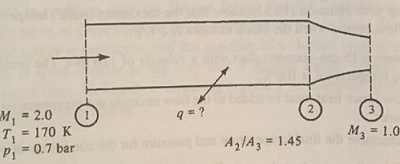Reference no: EM131073721
1. Air enters a constant-area duct with MI = 2.95 and 1) = 500°R. Heat transfer decreases the outlet Mach number to M2 = 1.60.
(a) Compute the exit static and stagnation temperatures.
(b) Find the amount and direction of heat transfer.
2. Air enters a duct with a Mach number of 2.0, and the temperature and pressure are 170 K and 0.7 bar, respectively. Heat transfer takes place while the flow proceeds down the duct. A converging section (A2/A3 = 1.45) is attached to the outlet as shown in Figure P10.11, and the exit Mach number is 1.0. Assume that the inlet conditions and exit Mach number remain fixed. Find the amount and direction of heat transfer:
(a) If there are no shocks in the system.
(b) If there is a normal shock someplace in the duct.
(c) For part (b), does it make any difference where the shock occurs?

3. The 12-in.-diameter duct shown in Figure P10.9 has a friction factor of 0.02 and no heat transfer from section 1 to 2. There is negligible friction from 2 to 3. Sufficient heat is added in the latter portion to just choke the flow at the exit. The fluid is nitrogen.

(a) Draw a T-s diagram for the system, showing the complete Fanno and Rayleigh lines involved.
(b) Determine the Mach number and stagnation conditions at section 2.
(c) Determine the static and stagnation conditions at section 3.
(d) How much heat was added to the flow?